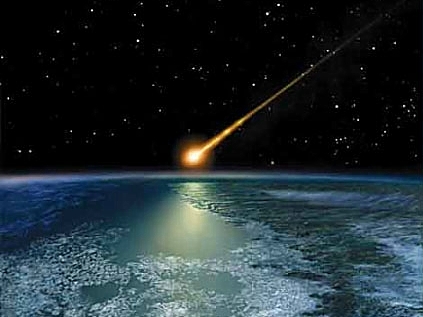Where did life come from? Its an old question whose answer(s) have been hotly debated down through history. Whether you prefer religious, scientific, or a mixing of the two for your answers, the truth of the matter is that we can never really know. The best we can hope for is a really good guess, mixed in with an awful lot of hope that we are not missing the point entirely.
Still, the question is a very interesting subject to ponder. Especially when we use science fiction to flesh out the weird and wonderful nature of life, death and the vast expanses of space-time.
One interesting theory is that life on Earth came from space. NASA researchers studying meteorites found that they contain several of the components needed to make DNA on Earth. The discovery provides support for the idea that the building blocks for DNA were likely created in space, and carried to Earth on objects, like meteorites, that crashed into the planet’s surface. According to the theory, the ready-made DNA parts could have then assembled under Earth’s early conditions to create the first DNA.
Check out this cool video for some of the details of this fascinating subject:
Of course such theories are just that; theories. However they ARE very interesting and and feed the imagination machine at the heart of all sci-fi writers, artists, dreamers and geeks. The idea that life can be helped along my space bullion cubes dropped into the chemical stew of a planet makes the possibilities of extraterrestrial (and extra-solar) life all the more possible.
Another variation on this theory is "Directed Panspermia" which is the seeding of worlds is directed by intelligent beings. In-essence this is a form of intelligent design, albeit a scientistic variant of the concept. The late Nobel prize winner Professor Francis Crick, OM FRS, along with British chemist Leslie Orgel proposed the theory of directed panspermia in 1973. A co-discoverer of the double helical structure of the DNA molecule, Crick found it impossible that the complexity of DNA could have evolved naturally.
Crick posed that small grains containing DNA, or the building blocks of life, could be loaded on a brace of rockets and fired randomly in all directions. Crick and Orgel estimated that a payload of one metric ton could contain 1017 micro-organisms organized in ten or a hundred separate samples. This would be the best, most cost effective strategy for seeding life on a compatible planet at some time in the future.
This theory is of-course fertile ground for science fiction of all kinds, as the concept of super-intelligent aliens are involved in seeding planets. The potential horror of this is rarely touched upon by hopeful scientists and mystical gurus of course.
The Science Fiction Treatment
In my favorite science fiction books, comics, movies and RPGs (including the X-Plorers RPG), life is widely spread across the galaxy. Though you still get really weird alien life, many worlds not only support life, but this life falls into categories that are comparable to life here on Earth. Plants are plants (and often falling into familiar forms such as trees, grass and flowers), and animals not that different from Earth reptiles, mammals, insects etc are all in evidence.
Though members of X-Plorers teams would be happy to find habitable worlds where potential food is available and air is breathable, one must sometime wonder why so many worlds in the reaches are inhabitable. If they were terraformed, than by whom? And will they mind finding all of these pesky humans messing up their planets?



No comments:
Post a Comment